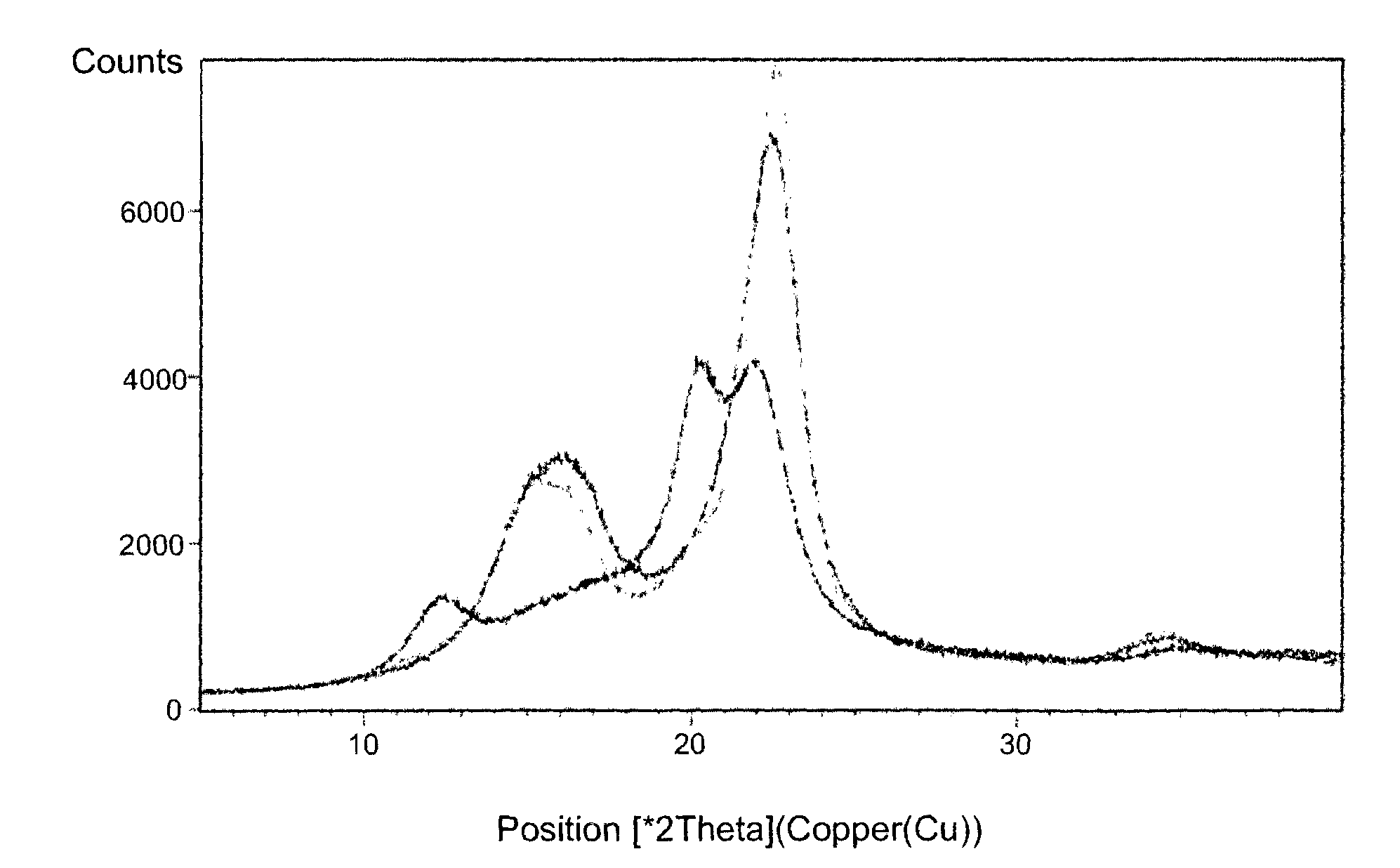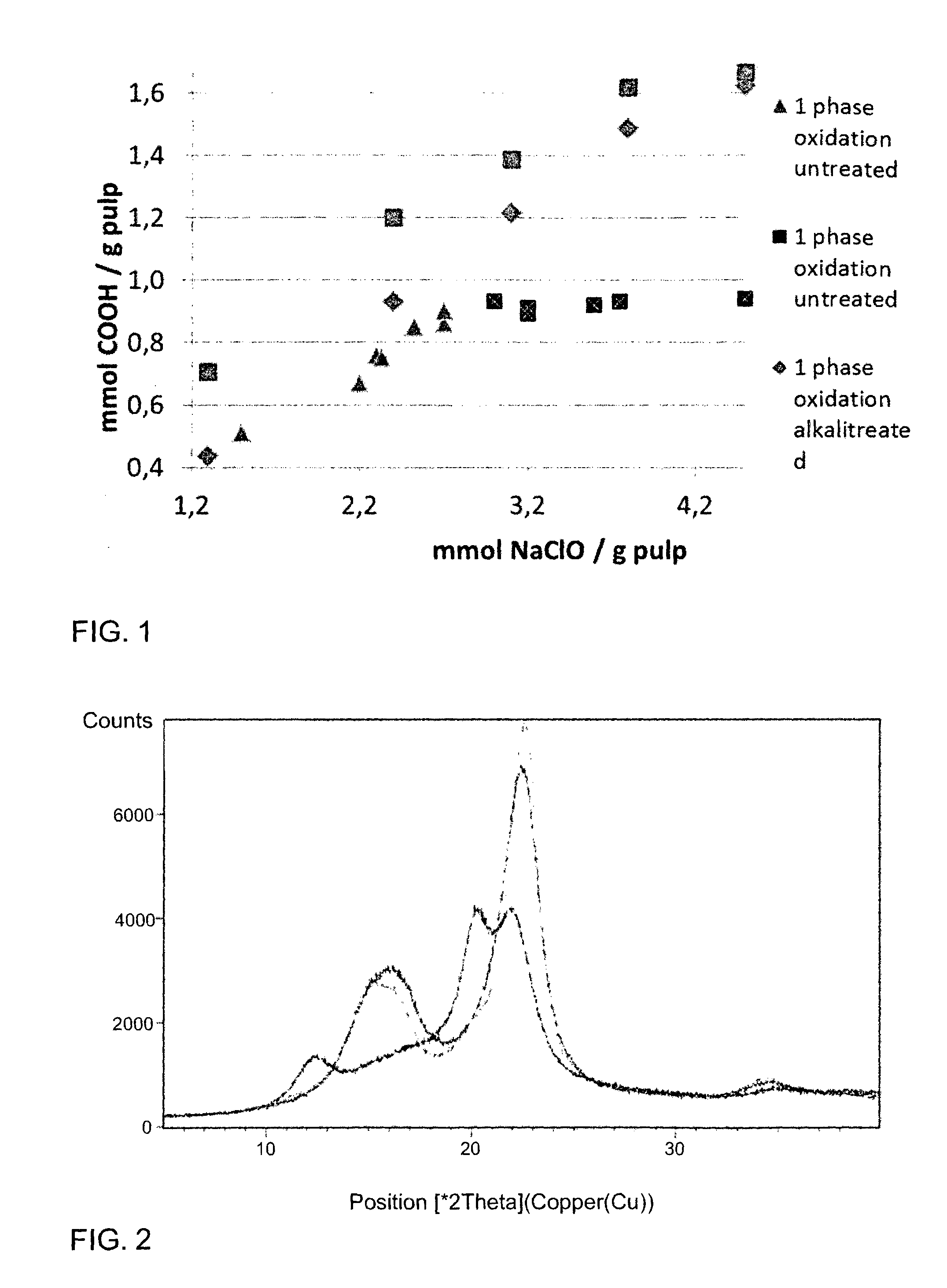Method for catalytic oxidation of cellulose and method for making a cellulose product
- Summary
- Abstract
- Description
- Claims
- Application Information
AI Technical Summary
Benefits of technology
Problems solved by technology
Method used
Image
Examples
example 1
Reference Oxidation (Pulp No. 1), No Alkaline Treatment
Activation of Radical TEMPO
[0079]0.375 g radical TEMPO was weighted and transferred to closed glass bottle. 50 ml of water was added to bottle. 4 ml of NaClO (12.9%) solution was added to TEMPO solution. pH of TEMPO solution was adjusted to 7.5 by 1 M H2SO4 using pH meter. Solution was mixed strongly until all radical TEMPO was dissolved.
HOCl Activated TEMPO Oxidation
[0080]243 g (48 g as dry) never-dried birch pulp was weighted in closed vessel. Activated TEMPO solution was mixed with pulp. Pulp was shifted to Buchi reactor and 819 ml water was mixed with pulp. Temperature of pulp was set to 18° C. 63 ml (12.9%) NaClO was added to reactor by pump while pulp was mixed strongly. NaClO addition was over after 13 min. pH was kept under 9 during NaClO addition by controlling pumping speed. Temperature of pulp was lifted to 25° C. after NaClO addition and pH was controlled by titrator (pH 9, 1 M NaOH) until all NaClO was consumed (aft...
example 2
Alkaline Treatment of Birch Pulp in 1M NaOH and Subsequent Washing
Alkaline Treatment
[0082]700 g (65.66 g abs dry) of never-dry pulp together with 155 ml of 8M NaOH solution and 635 ml of additional water was added to a large beaker to obtain 5% consistency and 1M NaOH concentration. The mixing began immediately after NaOH addition with a mechanical mixer. The temperature of the slurry was measured during the initial state of the mixing.
Washing to pH 9
[0083]After the treatment time (15 minutes), the pulp slurry was transferred to a wire bag and immediately washed with deionized water. The pH of the pulp slurry was determined at around 5% consistency. The washing was continued until the pH of the pulp slurry was around 9. Then, excess of water was removed manually to obtain a higher consistency of the pulp. The pulp was mechanically disintegrated prior to the following oxidation stage.
example 3
Oxidation after Alkali Treatment and Washing / Medium Carboxylate Content (Pulp No. 2)
Activation of Radical TEMPO
[0084]0.375 g radical TEMPO was weighted and transferred to closed glass bottle. 50 ml of water was added to bottle. 4 ml of NaClO (13.1%) solution was added to TEMPO solution. pH of TEMPO solution was adjusted to 7.5 by 1 M H2SO4 using pH meter. Solution was mixed strongly until all radical TEMPO was dissolved.
HOCl Activated TEMPO Oxidation
[0085]226 g (46 g as dry) alkali treated never-dried birch pulp was weighted in closed vessel. Activated TEMPO solution was mixed with pulp. Pulp was shifted to Buchi reactor and 839 ml water was mixed with pulp. Temperature of pulp was set to 18° C. 60 ml (13.1%) NaClO was added to reactor by pump while pulp was mixed strongly. NaClO addition was over after 14 min. pH was kept under 9 during NaClO addition by controlling pumping speed. Temperature of pulp was lifted to 25° C. after NaClO addition and pH was controlled by titrator (pH 9,...
PUM
| Property | Measurement | Unit |
|---|---|---|
| Fraction | aaaaa | aaaaa |
| Fraction | aaaaa | aaaaa |
| Fraction | aaaaa | aaaaa |
Abstract
Description
Claims
Application Information
 Login to View More
Login to View More - R&D
- Intellectual Property
- Life Sciences
- Materials
- Tech Scout
- Unparalleled Data Quality
- Higher Quality Content
- 60% Fewer Hallucinations
Browse by: Latest US Patents, China's latest patents, Technical Efficacy Thesaurus, Application Domain, Technology Topic, Popular Technical Reports.
© 2025 PatSnap. All rights reserved.Legal|Privacy policy|Modern Slavery Act Transparency Statement|Sitemap|About US| Contact US: help@patsnap.com



